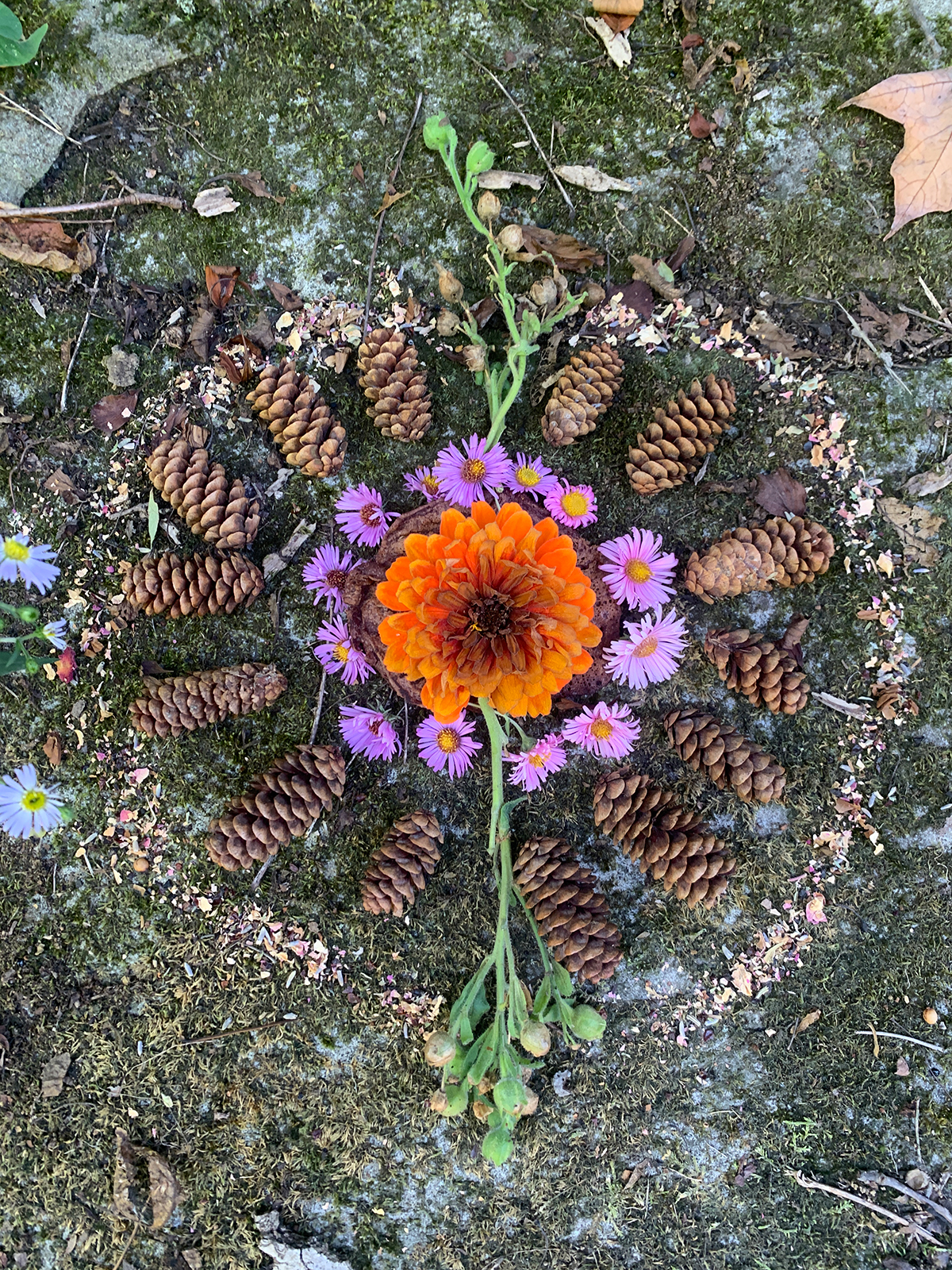 A woman comes to a clearing in the recently burned forest with a basket of stones, sticks, nuts, and flowers. She begins to sing, laugh, and dance as she creates a beautiful circle with the materials. As she weaves her healing magic, the design of the circle grows more complex, spiraling inward and outward. She finishes her work and sits with it quietly for a time, before leaving it in place to do its own work. A healing mandala has been made on that spot, to help the forest recover after a fire.
A woman comes to a clearing in the recently burned forest with a basket of stones, sticks, nuts, and flowers. She begins to sing, laugh, and dance as she creates a beautiful circle with the materials. As she weaves her healing magic, the design of the circle grows more complex, spiraling inward and outward. She finishes her work and sits with it quietly for a time, before leaving it in place to do its own work. A healing mandala has been made on that spot, to help the forest recover after a fire.
Nature mandalas can be used for a variety of inner work, healings, blessings and rituals and are a wonderful addition to a druid or natural spiritual practice. Nature mandalas are an intuitive magical and bardic arts practice that works with the connection of your own subconscious to the living earth. You use materials that are local to you, in season, to create beautiful patterns with sacred intent.
On writing about mandalas, C. F. Jung, the esoteric psychologist, spoke of the benefits of creating mandalas as a way of seeing deeply into the psyche and allow for the cyclical process of self-development. Mandalas have been used in a variety of traditions, as he describes, primarily for inner spirit work—as the mandala is constructed, understanding, enlightenment, or healing may come. A mandala can be done in combination with other practices (ritual work, meditation, land healing and/or blessing) or they can be done on its own. Mandalas can also be done by anyone at any point in their practice, regardless of their ability to raise energy, visualize, or engage in any other advanced ritual techniques.
Creating a Nature Mandala
Space Selection. To create a mandala, select a flat space where you are able to lay out a pattern: a flat river bank or shore, a sandbar, a bare spot in the forest, a space in the lawn in your backyard, a dirt patch, a large stone, etc. Mandalas can be large or small and can be done in places where water can wash them away (a beach at low tied, the edge of a stream that will eventually flood, etc.), in the snow that will melt, etc.
Ephemeral nature. In fact, I would argue that their very ephemeral nature is part of that magic of the nature mandala: the mandala is created in the moment for a sacred purpose using materials local to the land. After creation, it is left in the natural world, and nature’s processes will claim it again tomorrow. As that claiming takes place, the mandala’s magic unfolds.

Design and Creation. In terms of the design of the mandala, many options are possible, some intentional and some intuitive. There is no right or wrong way to create a mandala. You can create intuitive designs, setting your intention, putting yourself in a meditative place, and letting your subconscious guide you to create the mandala. If you are going to do this approach, I suggest before you begin, spending time communing with the land. Walking with the land, hearing the voices of the spirits in the wind, in your inner mind, feeling the energies present. Attune with those, and when you feel connected and centered with this place, create. This approach allows you to connect with the land and bring forth a design that is unique to the land, to your interaction, and to the place. This can lead to some really amazing designs and experiences. I really like creating intuitive mandalas. They don’t have to be circular, they can weave around existing material in the landscape. They can be full of nature’s patterns: spirals, leaves, waves, circles, and more. You can make mandalas to fit a landscape and space of any size or composition. Go in without a plan. Connect to the world around you. Just start laying things in a pattern. See what unfolds. Smile, dance, and be happy. Breathe.
On the intentional side, Jung noted that many mandalas in other cultures unfolded in a circular four-fold pattern, tying to the four elements and other four-fold patterns in the universe. While we see a four-fold pattern in nature (in the flowers of a dogwood tree or in the small flowers in the arugula plant), this is only one possible pattern nature provides. The flowers of apples and hawthorns show us a five-fold pattern, the shell of a snail shows us a spiral pattern, and the flower of a trillium shows us a three-fold pattern. These and many other patterns can be used for inspiration. For more on nature’s patterns, see this post.
The alternative is to plan it out. I would suggest planning only if you are doing it with a group as part of a larger ritual or practice and/or if you are creating mandalas that will be of a more permanent nature. Planning your mandala can include sketching it in advance, planning out and gathering your materials, and preparing the space. The photo here is of a magical mandala that we created for a ley line ritual at the MAGUS Gathering in 2018. This was obviously intentionally planned in advance so that we could have it at the start of our ritual.
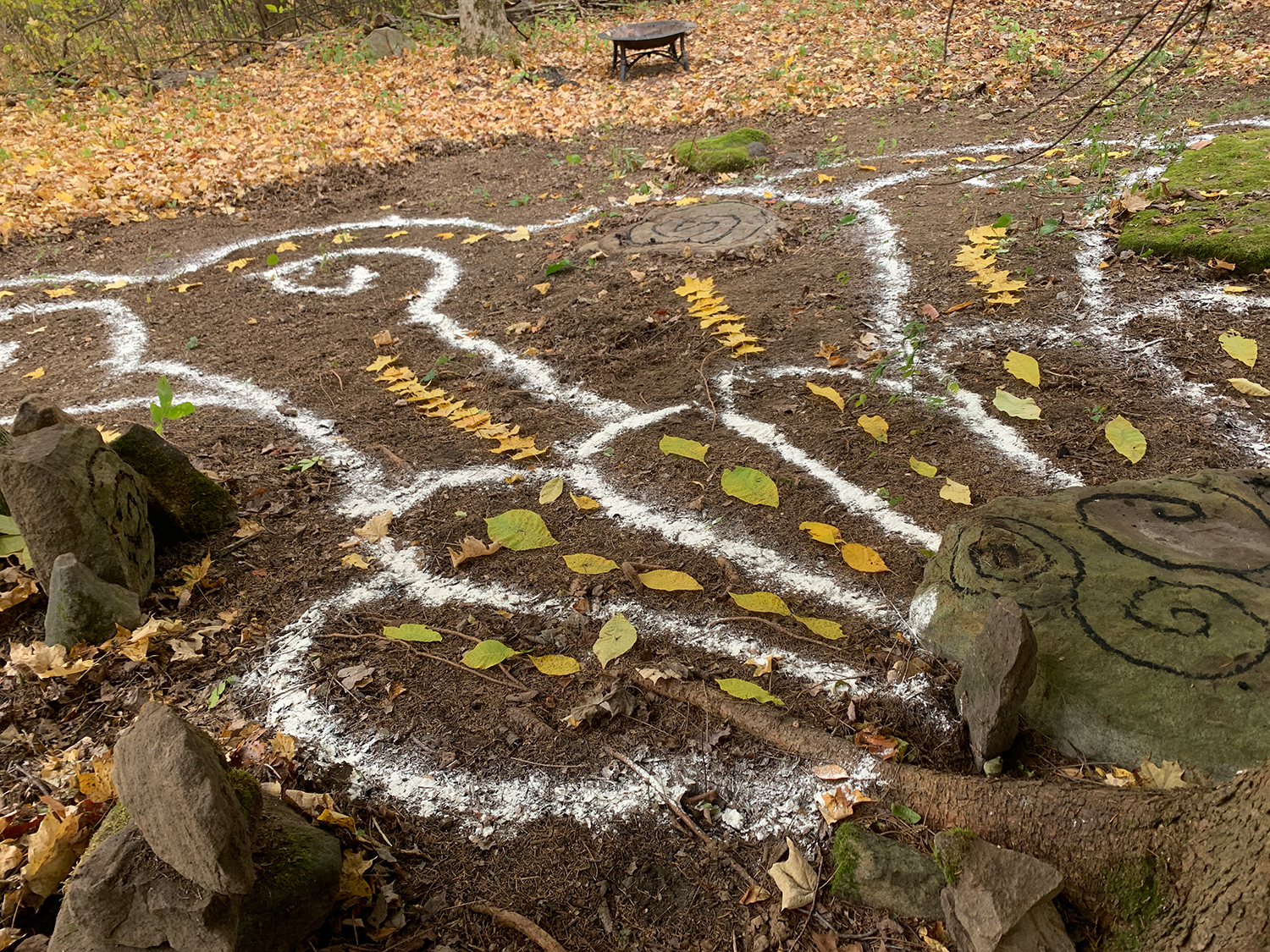 Mandalas and other Spiritual Work. The act of mandala creation is a ritual in and of itself–but you also might want to use it in combination with other practices. For example, you can use it as an anchor point for other ritual activity in this chapter, creating a mandala around a sacred space that you can sit in, meditate in, do other kinds of ritual in, or even, leave magical tools for further empowerment in. I like to create mandalas as part of rituals; I use the mandala creation as a way of beginning my ritual work before moving into a formal ritual. Or, you can simply be present with it for a time, spend a quiet moment in meditation, and then let it be, knowing that work continues on nature’s time.
Mandalas and other Spiritual Work. The act of mandala creation is a ritual in and of itself–but you also might want to use it in combination with other practices. For example, you can use it as an anchor point for other ritual activity in this chapter, creating a mandala around a sacred space that you can sit in, meditate in, do other kinds of ritual in, or even, leave magical tools for further empowerment in. I like to create mandalas as part of rituals; I use the mandala creation as a way of beginning my ritual work before moving into a formal ritual. Or, you can simply be present with it for a time, spend a quiet moment in meditation, and then let it be, knowing that work continues on nature’s time.
Possibilities for Nature Mandalas
There are so many possibilities for working with Nature Mandalas. I offer some suggestions for different ways you can create mandalas.
Nature Mandala with sticks, shells, stones, and other things. Begin gathering the materials for the mandala, using your intuition. A basket here also helps! As you gather, be careful not to disrupt the ecosystem (e.g. use fallen sticks, leaves, small stones, leave big stones where they are). When you have gathered your materials, begin to organize them in some circular or spiral fashion. There is no right or wrong way, just flow with the spirits of the land. With each piece of the mandala, you can set intentions for the healing of the land (e.g. “this leaf represents the new growth of spring. This stone represents the health of the insect life” and so forth).
Fall Leaf Mandala. A very beautiful mandala can be created using fall leaves. Just as they fall, gather them, and weave them into patterns to celebrate the autumn and the sacredness of this time.

Nature mandala with snow. If you are in an area with snowfall and laying snow, the better approach is to weave your mandala into the snow itself. To do this, simply close your eyes and visualize the shape you want your mandala to take—or just start walking. You can use a big open area or you can use a wooded area where you work the trees, stones, and other natural features into your design. Walk your mandala each day the snow is present, if possible, to leave lasting healing on the landscape.
Nature mandala with sand or soil. Another option for a nature mandala is in the sand or bare soil. You might use a stick to trace patterns, adding stones or shells. You might use your feet to trace to walk a larger path of the mandala. Mandalas on the shore, placed at the low tide line, will be taken by the sea, and thus, can be used as a blessing for the oceans. Mandalas placed higher on the shore can bless the land around them. Mandalas on the edges of river banks can be done in a similar manner, as rivers flood.
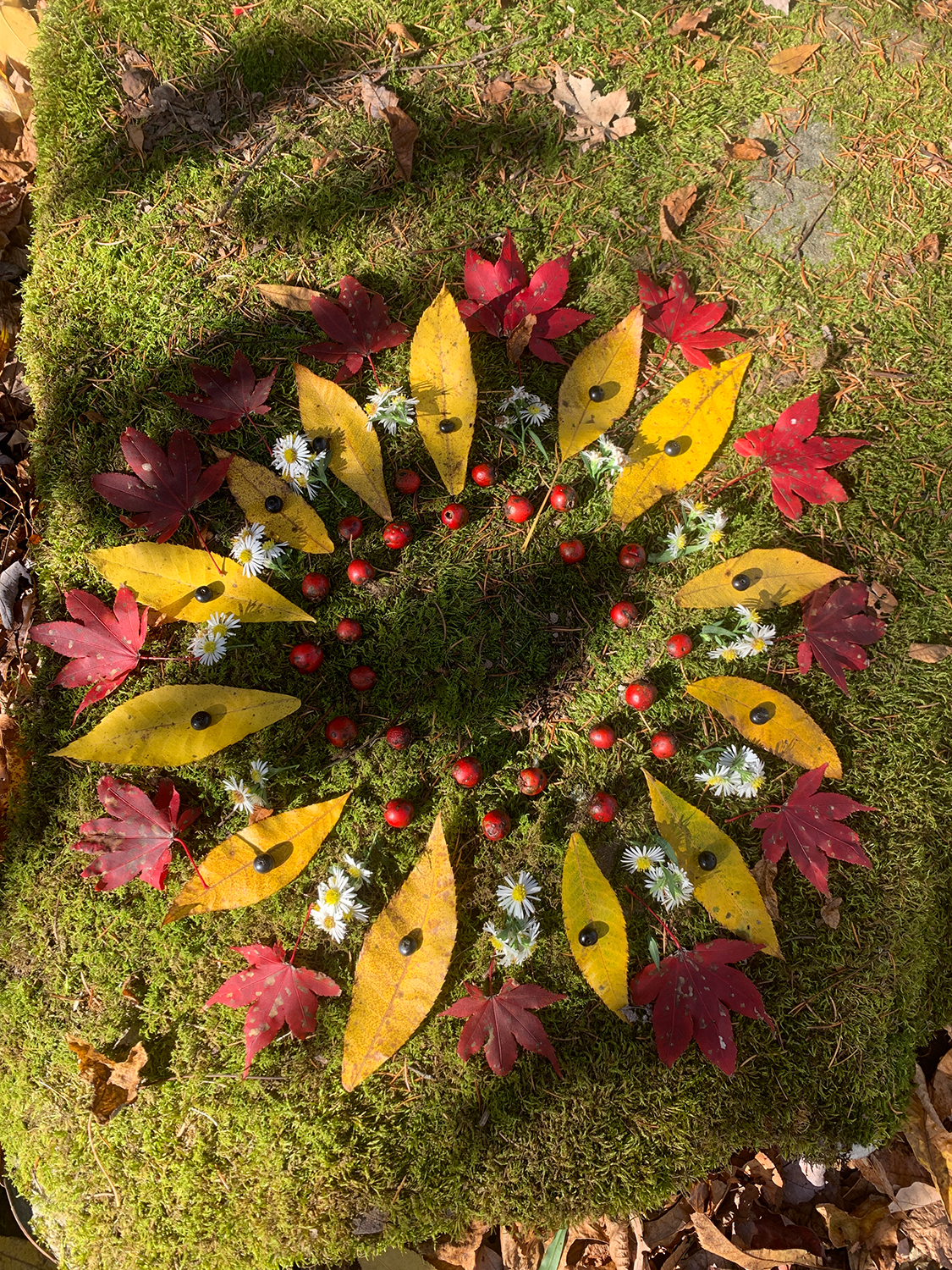
Flour or Cornmeal Mandala. You can create a mandala by using flour or cornmeal (and cornmeal comes in several colors). To do this, you will want some kind of vessel that makes it easy to pour a little bit out at once–a commercial dressing container with a larger opening, a gallon jug (use a funnel to get it in there) or even a water pitcher can all work as a basic tool. For this kind of mandala, it is best to have a sand or dirt surface. I often make these in our sacred grove; in the fall months, I rake up the leaves and then work with the bare surface to weave patterns of cornmeal, leaves, and patterns. As fall turns to winter and the snows come, I work with the snow in the grove instead, continuing to layer energies in that sacred space.
Stone mandala. A more permanent option is to create a mandala with stones, leaving it somewhere to simply “be”. I would suggest this only at sites that have already had major disruption, as you do not want to disrupt the ecosystem itself by moving stones.
One last point about the different kinds of mandalas—make sure that in your mandala creating, you don’t disrupt the natural world. Stones of any size are often home to insects and other life and removing them can disrupt the ecosystem. Don’t remove large stones or remove them from rivers, etc. Pick up and use things that are already ephemeral: small stones that are moved by the river or waves, nuts, sticks, leaves.
Some examples
I’ll offer a few examples of the different ways I’ve used mandalas in my practice recently. These examples are meant to help spark your own creativity and ideas!

The first example is an offering mandala. I made this mandala after creating acorn pancakes on the fall equinox from the acorns being dropped from our ancient oak tree. It is this tree that I have been working with my Tree for a Year practice, and it’s this tree that I’ve made acorn ink from, and now, the acorn pancakes. As part of an offering practice, I wanted to offer gratitude to this oak.

The second example was another recent mandala, this one with the purpose of preparing a magical space. I have been drawn to a particular section of our sacred grove for a while (a Norway spruce tree with a large stone underneath, and a hickory nearby) and had a vision of some visionary and magical work to do there in the coming months. As part of this, I raked and cleared a small section and made a flour and leaf mandala as saying “hello” to the space and honoring it. I decided on a flour mandala because I had found some flour infested by flour moths, so I wanted to make good use of it but get it out of the kitchen! Plus, flour mandalas look great against bare earth! The purpose of this mandala was honoring this sacred space and beginning to lay energetic patterns for future ritual work.
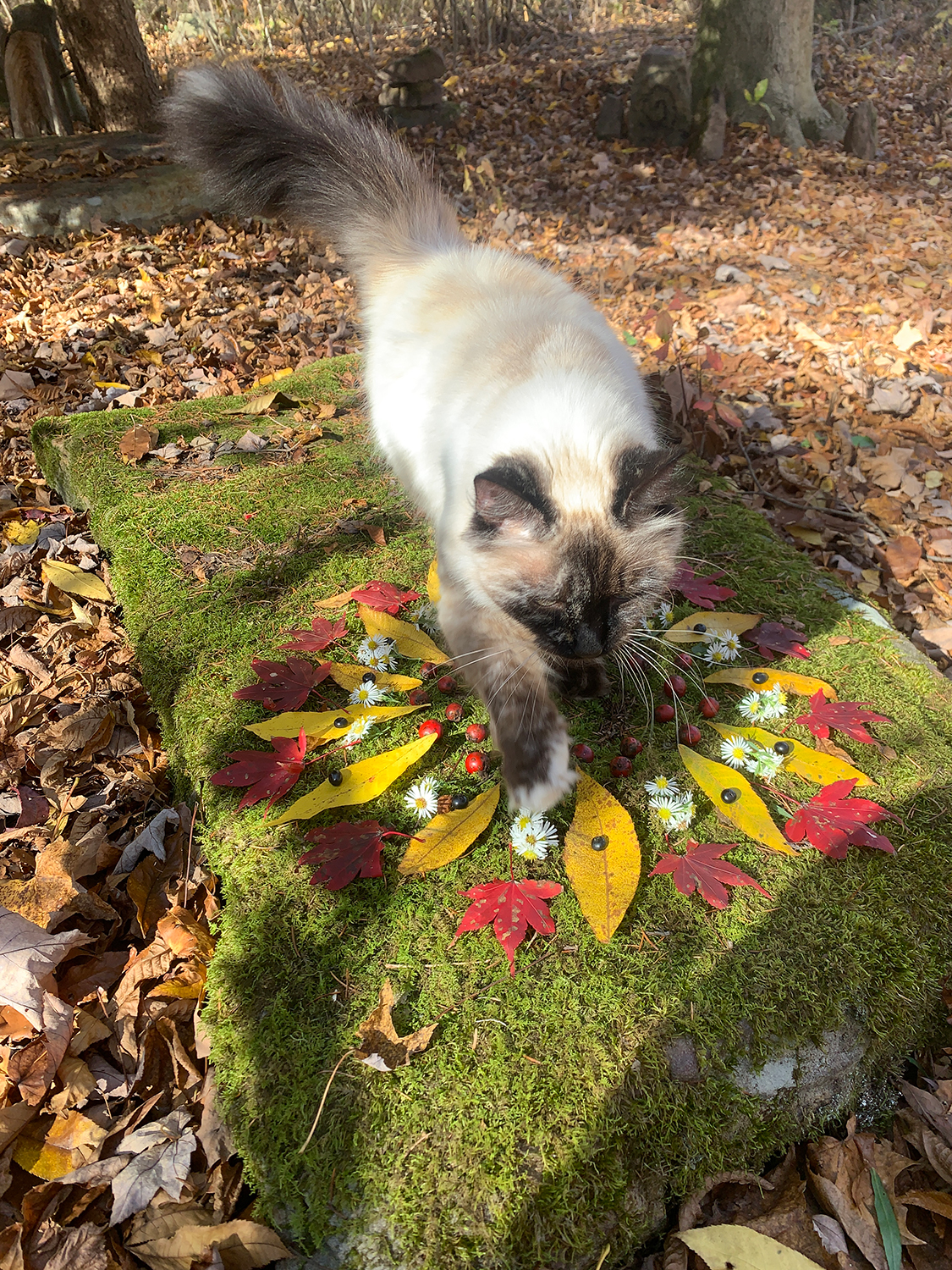
The final example is one I did simply to bring peace and calm. As the leaves were falling, I simply went out and worked with them, making patterns, and working to provide calm and healing. And it worked!
I hope that this post has offered you some inspiration. I would love to see any mandalas that you create! Please consider sharing them here and/or tagging me on Instagram (@druidsgardenart). Blessings upon your journey!
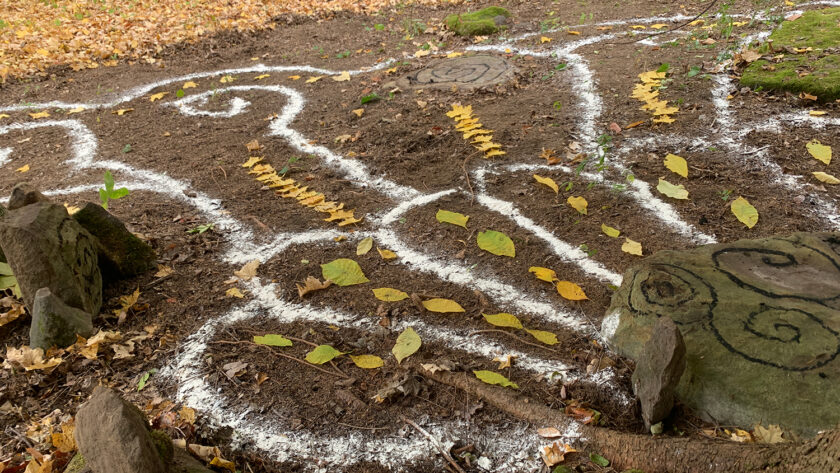

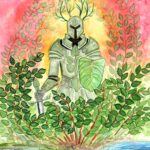

Reblogged this on Blue Dragon Journal.
Thanks for the reblog!
I always enjoy your detailed articles, Dana.
Reblogged this on Paths I Walk.
Thanks for the reblog!
Reblogged this on GrannyMoon's Morning Feast.
[…] Nature Mandalas for Inner Work, Rituals, and Blessings — The Druid’s Garden […]
Reblogged this on Good Witches Homestead.
Reblogged this on Premium Plan Site.